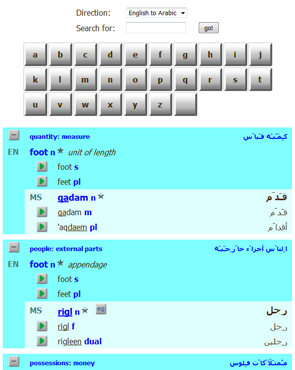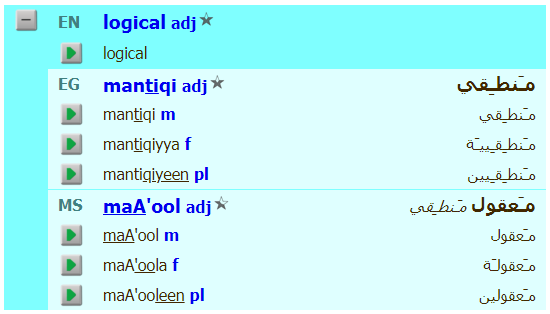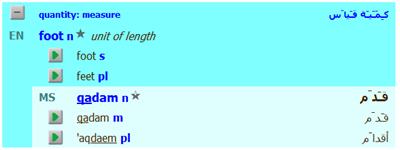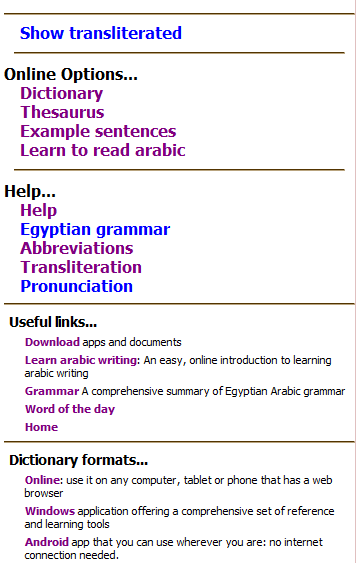Search view
This page explains how to use the search view of the Egyptian Arabic Dictionary. With the search view, you can find a word even if you are not sure how to spell it.
Buttons

At the top left of the display is a or button . Arabic words are displayed both in arabic writing and in european letters. There are two options for displaying words in european letters- transliterated and pronounced. You can click on and to switch between the two. For more information about the differences between the two systems and an introduction to arabic writing, see Arabic Writing.
At the top right is a  or
or  flag that can switch the user interface between English and Arabic
.
flag that can switch the user interface between English and Arabic
.
Point at the image below for brief notes about each area. Click on an area for full information about its use.

Selection form

At the top of the page is an area to specify what word you are looking for.
First, select the Direction. For example, if you want to look up an English word and find equivalent Egpytian words, set it to English to Egyptian.
Next, type in the word to Search for. You don't have to spell the word exactly right: it will offer you a list of the words most similar to what you typed in. If you are entering an Egyptian word, you can use either arabic letters with or without tashkyl, or transliterated. You can use either your computer keyboard or the on-screen keyboard.
When you have entered the word, hit the Enter key or press the button. Your results will appear shortly.
On-screen keyboard

If you want to find an arabic word and you don't have an arabic keyboard, you can use the on-screen keyboard. Use the button in the bottom right to select whether to show arabic or european letters on the keys- if there is enough space, both are displayed anyway.
Results
The following picture shows the results. The page lists up to twenty words that are similar to the letters that you typed in. Each word is followed by one or more words in the other language.
The information for each word and its meaning is displayed in a very compact form: the following sections explains how to interpret the information.

Initially, only a summary of the details for a word is displayed.
Click on the  button to expand the details,
showing the main forms for the word, as in the picture below. Click on the
button to expand the details,
showing the main forms for the word, as in the picture below. Click on the  button to collapse it again.
button to collapse it again.

Point at an item on the image to see brief notes about it. Click on it for full information about its meaning.

Language
The displayed code indicates the language of the word. Point the mouse at the code to see the language name in full.
Word
Arabic words are shown in both arabic writing and either transliterated or pronounced form: you can use the button at the top to select whichever you prefer. When you select pronounced, the stressed syllable in each word is underlined.
You can touch the word to see full details for the word, including a list of words with similar meanings.
Grammatical element
The code after the word indicates the type of word, for example n for noun or v for verb. Touch the code to see definitions of the abbreviations.
Usage
The usage is a star indicating how frequently the word is used: the options are
 - daily
- daily - regularly
- regularly - occasionally
- occasionally - understood but rarely used
- understood but rarely used - not always understood
- not always understood- no star - unrated
Examples
If the word appears in any examples, the  button is displayed. You can click on it to see the example sentences that use this word.
button is displayed. You can click on it to see the example sentences that use this word.
Verb
If the word is a verb and there are sufficient details in the database,
the  button is displayed. You can click on
it to see a full list of all the tenses and cases that are valid for this verb.
button is displayed. You can click on
it to see a full list of all the tenses and cases that are valid for this verb.
Notes
Some words have more than one meaning, for example sheet could be a piece of paper or something that goes on the bed. The notes explains which meaning this word has.
Play
Touch the  button to hear somebody saying the word.
button to hear somebody saying the word.
Form
Some words exist in more than one form, for example singular and plural. For most words, there is a list of the forms necessary to derive all other forms. Next to the word, there is a code that indicates the type of form, for example m for masculine and f for feminine. Touch the code to see a summary of the abbreviations.
Sidebar
The sidebar is displayed on the left of the screen on computers and below the search results on phones.

Show transliterated / Show pronounced
Arabic words are displayed both in arabic writing and in european letters. There are two options for displaying words in european letters- transliterated and pronounced. You can click on this to switch between the two.
For more information about the differences between the two systemd ans an introduction to arabic writing, see Arabic Writing.
Menu
The menu appears on the left of the main information of the page. The menu contains links to the main online functions, to help pages like this one, and to several other useful locations on the site.
